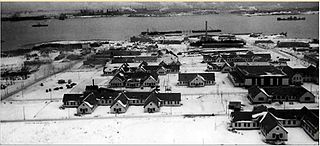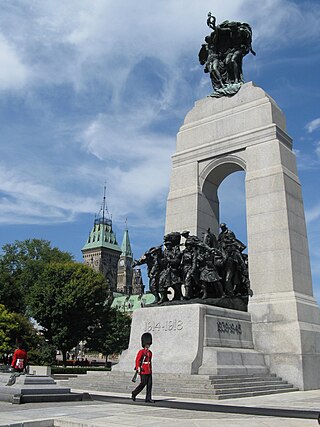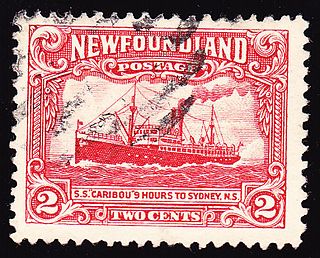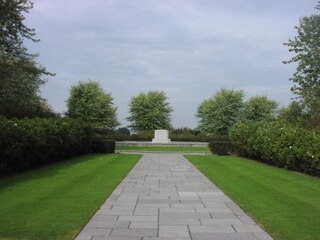Related Research Articles

Sydney is a former city and urban community on the east coast of Cape Breton Island in Nova Scotia, Canada within the Cape Breton Regional Municipality. Sydney was founded in 1785 by the British, was incorporated as a city in 1904, and dissolved on 1 August 1995, when it was amalgamated into the regional municipality.

The Fortress of Louisbourg is a tourist attraction as a National Historic Site and the location of a one-quarter partial reconstruction of an 18th-century French fortress at Louisbourg on Cape Breton Island, Nova Scotia. Its two sieges, especially that of 1758, were turning points in the Anglo-French struggle for what today is Canada.

Vimy is a commune in the French department of Pas-de-Calais. Located 3.8 kilometers (2.4 mi) east of Vimy is the Canadian National Vimy Memorial dedicated to the Battle of Vimy Ridge and the Canadian soldiers who were killed during the First World War. The Memorial is also the site of two Canadian cemeteries.

Walter Seymour Allward was a Canadian monumental sculptor best known for the Canadian National Vimy Memorial. Featuring expressive classical figures within modern compositions, Allward's monuments evoke themes of memory, sacrifice, and redemption. He has been widely praised for his "original sense of spatial composition, his mastery of the classical form and his brilliant craftsmanship".

Royal Canadian Navy base HMCS Protector, also known as the Point Edward Naval Base, was located next to Sydney Harbour, on Nova Scotia's Cape Breton Island. It was founded in 1940 and used by the navy during the Second World War. It was mainly used to provision, protect and repair the various merchant marine convoys to Quebec, Halifax, and the United Kingdom. It was a main combat zone during the Battle of the St. Lawrence and the more general Battle of the Atlantic. It continued to be utilized during the Cold War's early stages. It was decommissioned in 1964 and became the initial facility to house the Canadian Coast Guard College that same year. Currently, the Sydport Industrial Park utilizes the base's former piers and land.

The Canadian National Vimy Memorial is a war memorial site in France dedicated to the memory of Canadian Expeditionary Force members killed during the First World War. It also serves as the place of commemoration for Canadian soldiers of the First World War killed or presumed dead in France who have no known grave. The monument is the centrepiece of a 100-hectare (250-acre) preserved battlefield park that encompasses a portion of the ground over which the Canadian Corps made their assault during the initial Battle of Vimy Ridge offensive of the Battle of Arras.
Chéticamp is an unincorporated town on the Cabot Trail on the west coast of Cape Breton Island in Nova Scotia, Canada. It is a local service centre. A majority of the population are Acadians. Together with its smaller neighbour, Saint-Joseph-du-Moine, Chéticamp makes up the largest Francophone enclave on Cape Breton Island. The 2006 population was 3,039 people.

The National War Memorial, titled The Response, is a tall, granite memorial arch with accreted bronze sculptures in Ottawa, Ontario, designed by Vernon March and first dedicated by King George VI in 1939. Originally built to commemorate the Canadians who died in the First World War, it was in 1982 rededicated to also include those killed in the Second World War and Korean War and again in 2014 to add the dead from the Second Boer War and War in Afghanistan, as well as all Canadians killed in all conflicts past and future. It now serves as the pre-eminent war memorial of 76 cenotaphs in Canada. In 2000, the Tomb of the Unknown Soldier was added in front of the memorial and symbolizes the sacrifices made by all Canadians who have died or may yet die for their country.

SS Caribou was a Newfoundland Railway passenger ferry that ran between Port aux Basques, in the Dominion of Newfoundland, and North Sydney, Nova Scotia between 1928 and 1942. During the Battle of the St. Lawrence the ferry participated in thrice-weekly convoys between Nova Scotia and Newfoundland. A German submarine attacked the convoy on 14 October 1942 and Caribou was sunk. She had women and children on board, and many of them were among the 137 who died. Her sinking, and large death toll, made it clear that the war had really arrived on Canada's and Newfoundland's home front. Her sinking is cited by many historians as the most significant sinking in Canadian-controlled waters during the Second World War.

The Le Quesnel Memorial is a Canadian war memorial that commemorates the actions of the Canadian Corps during the 1918 Battle of Amiens during World War I. The battle marked the beginning of a 96-day period known as "Canada's Hundred Days" that saw the crumbling of the German Army and ultimately the Armistice that ended the war. The memorial is located just to the southwest of the village of Le Quesnel, on the road between Amiens and Roye, in northern France.

The Courcelette Memorial is a Canadian war memorial that commemorates the actions of the Canadian Corps in the final two and a half months of the infamous four-and-a-half-month-long Somme Offensive of the First World War. The Canadians participated at the Somme from early September to the British offensives end in mid-November 1916, engaging in several of the battles-within-the-battle of the Somme, including actions at: Flers-Courcelette, Thiepval Ridge, the Ancre Heights, the Ancre as well as a small role in providing relief to the First Australian Imperial Force in the final days of the Battle of Pozières. The battles on the Somme were the first in which all four Canadian divisions participated in the same battle, although not together in a cohesive formation. The Canadian divisions suffered over 24,000 casualties.
Cottage country is a common name in Ontario, New Brunswick, and other regions of Canada for areas that are popular locations for recreational properties such as cottages and summer homes. Cottage country is often socially, culturally, economically, and politically distinct from other rural areas in that it is populated by a notably higher concentration of urban vacationers and residents who have an affinity for the outdoors, in contrast to more traditional rural populations, which are largely absent of "city folk", but that is less true in Western Canada. Any major population centre may have its own popular "cottage country" area.

The Stone Carvers (2001) is a novel by the Canadian writer Jane Urquhart, focusing on the historical events of World War I, and the fictional town of Shoneval, Ontario.

The Bell Memorial is a memorial designed by Walter Seymour Allward to commemorate the invention of the telephone by Alexander Graham Bell at the Bell Homestead National Historic Site, in Brantford, Ontario, Canada.

Taylor Josephine Stephanie Luciow, known by her stage name Taylor Mitchell, was a Canadian country folk singer and songwriter from Toronto. Her debut and only album, For Your Consideration, received encouraging reviews and airplay. Following a busy summer performance schedule, which included an appearance as a young performer at the Winnipeg Folk Festival, Mitchell embarked on a tour of Eastern Canada with a newly acquired license and car.

The Calgary Soldiers' Memorial is a war monument in Calgary, Alberta, that was dedicated on April 9, 2011, the anniversary of the Battle of Vimy Ridge. The monument is dedicated to Calgary area soldiers who have given their lives in war and military service overseas. The monument is located on Memorial Drive and bears the names of 3,000 fallen soldiers from the Calgary area who died in military service.

The Shrine Peace Memorial is a memorial sculpture on the grounds of Exhibition Place in Toronto, Ontario, Canada. The monument was presented to the people of Canada on June 12, 1930 by the Ancient Arabic Order Nobles of the Mystic Shrine as a symbol of peace and friendship between the United States and Canada. It is also meant as "an ongoing reminder that Freemasonry actively promotes the ideals of peace, harmony, and prosperity for all humankind". The location is thought to be the location that American troops landed during the War of 1812 for the Battle of York.

Wentworth Park is a Canadian urban park located in the community of Sydney, part of Nova Scotia's Cape Breton Regional Municipality. The park was created in 1786, just a year after Sydney's founding, making it the oldest of Sydney's parks. Wentworth Park incorporates the Kiwanis Bandshell, a playground, fountains, and a splash pad, as well as a 1.2 kilometres (0.75 mi) network of paved paths surrounding the park's ponds and flower beds.
Helen Ilona Vari was a Canadian philanthropist.
References
- 1 2 3 "Parks Canada backs out of controversial 'Mother Canada' war memorial project in Cape Breton". National Post. 5 February 2016. Retrieved 8 February 2016.
- 1 2 3 4 "Mother Canada statue won't be built in Cape Breton after all". Toronto Star. 5 February 2016. Retrieved 8 February 2016.
- 1 2 3 "Mother Canada project won't go ahead in Cape Breton park". CBC News. 6 February 2016. Retrieved 8 February 2016.
- 1 2 3 4 "'Mother Canada' statue creator sues Parks Canada, seeking to revive ridiculed project". Toronto Star. February 18, 2024. Retrieved February 19, 2024.
- ↑ "friendsofourfallen.ca". www.friendsofourfallen.ca. Retrieved 2019-12-12.
- ↑ "Parks Canada scraps plan for war monument at Green Cove | Cape Breton Post". www.capebretonpost.com. Retrieved 2018-08-18.
- ↑ "Mother Canada statue is hubristic, ugly and just plain wrong (editorial)". The Globe and Mail. 23 June 2015. Retrieved 8 February 2016.
- ↑ Post, Cape Breton. "Proposed Mother Canada monument provokes war of words over statue | Cape Breton Post". www.capebretonpost.com. Retrieved 2019-12-31.
- ↑ "Council voices support for proposed Never Forgotten National Memorial". BradfordToday.ca. 7 August 2019. Retrieved 2019-12-31.
- ↑ "Mother Canada statue's future under Liberal government review". CBC News. 4 December 2015. Retrieved 8 February 2016.
- ↑ "Rocky reception for war memorial at Green Cove". The Chronicle Herald. 2014-10-15. Retrieved 2018-08-18.